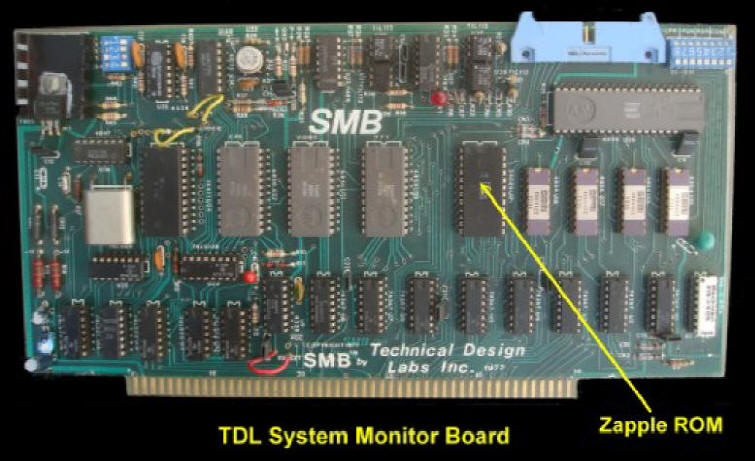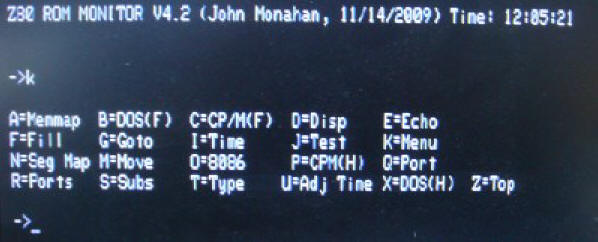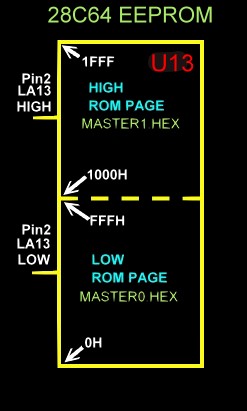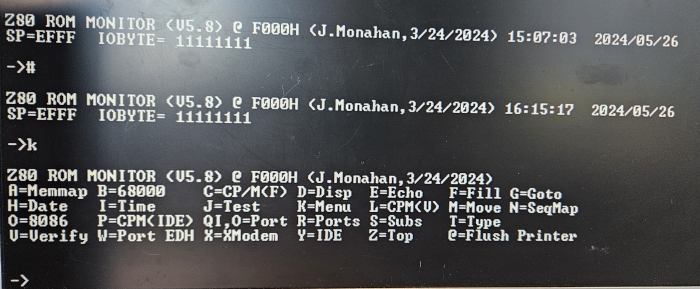
A Z80 Monitor Program
My first computer was
centered around the TDL system monitor board. This very useful S-100 board had a
wonderful Z80 monitor in its custom 4K ROM. It was called "Zapple". It was an extension
of an 8080 monitor program written by Roger Amidon called "Apple" back in the mid
70's. It had all the basic requirements such as allowing the user to examine/modify
RAM or IO ports. Output to a console, printer, punch, tape reader (these were the
Teletype days) or cassette recorder. It was really the first to do the obvious,
namely have all jump calls at the start of the program - for easy access by other
programs and allow redirection of output by changing an "IOBYTE" stored in an IO
port.

Over the years this monitor code has been copied and
modified many times over by others. I too have extensively modified it to
incorporate things like booting the first sector of a floppy disk to load
CPM. Or doing the same thing for my hard disk. I even have code in there to
direct output to my speech synthesizer, run a date/clock chip etc. I
no longer use the original SMB, instead the monitor now resides in the
EEPROM of the
S100Computers Z80 CPU Board.
I am enclosing the complete source code for the monitor (see Below).
MASTER.Z80
The above ROM based monitor
normally resides at 0F000H. However for testing purposes it can be assembled to
run at 100H where it should run in a CPM system with no conflicts. The monitor is
really split into two 2K sections. The first section contains a table for
all the "normal" monitor jump options like displaying or modifying memory or ports.
The second section at 0F800H contains a jump table for CPM BIOS routines. Some of
my older (pre-CPM3) software counts on these locations being there. The monitor
resided in a 2732 PROM chip on a Intersystems Z80 CPU board. As with any such monitor
there are some extremely hardware specific sections. Major sections consist of the
following:-
| |
 |
Setup all equates for ports and memory locations
The main Jump table to routines within the monitor
The A-Z command jump table
Initialization of serial and parallel ports (LED's on a IMSAI PIO board light up
one by one as sections are completed)
Send a text string to consol. String in [HL]
Get highest RAM location
available to Z80
Various parameter processing routines
Keyboard input routine
Console output routine
CONSOL status routine
Printer status and output
Boot CPM from hard disk (8255 driven IDE Drives or CF Cards)
Display a memory map of 64K
Display memory map for any segment up to 1 MG.
Query ports
Display all active ports from (0 to FFH)
Test RAM
Move and verify memory
Switch in another CPU (8086,
80286 or 68000 etc.)
At F800H, A jump table for CPM BIOS
Boot CPM from a floppy
CPM required
BIOS routines
Get Time from a 58167
or DS12887 clock chip
Hex math routines
Display ASCII in RAM
Send an
ASCII string to a speech chip
I/O from a serial port/modem
Download code from another Computer/PC over a serial/USB port and place it
in RAM at any location (0H to 0FFFFFH) using the XMODEM protocol.
Jump to code in RAM. As you can see the program
is written in Z80 code. It should assemble with almost any Z80 assembler. In the
past I used the SD Systems assembler simply because that's what I started with. It has a
slight quirk in that the data fields "DB", "DW" require "DEFB"
and "DEFW". The good news
is that strings can be written with "DEFM". I also used the
Cromemco Assembler, but that one has a quirk in that it will not accept
names with "$" or "_" character.
I have now switched over all my
stuff to the SLR Z80 assembler. Kicking myself i did not do this earlier!
It is extremely fast and produces .COM or .HEX files directly. To
review and download a CPM based assembler go
here.
Z80 Monitor Software For The V2 Z80 CPU Board.
This ability to flip 4K "pages" within the ROM in
the
V2 Z80 CPU Board effectively allows one to almost
double the effective size of the code in your Z80 monitor. The only thing
to watch out for is that the actual code used for the switch reside in EXACTLY
the same place in both 4K pages. I have modified the above well tested
Master.Z80 monitor to have Floppy disk/CPM booting code in the lower 4K and the
ability to download a XModem formatted file directly to RAM from a PC (via a
serial port) in the upper 4K. You can actually do a lot with 8K of ROM with
a Z80 -- just be careful about the common code used during the switch.
Here is a Video of the V2-Z80 Board Monitor with the file transfer
command running:-
Z80 Monitor Software V5.5 for theV2 Z80 CPU Board.
This ability to flip 4K "pages" within the ROM in
the
V2 Z80 CPU Board as described above works fine, however it is very
inefficient in terms of ROM bytes utilized. It is essentially a
duplication of the lower page in the upper page with a few lower routines
replaced with the XModem menu option in the upper page. The menu text
for example is in both pages and one has to enter a menu option "XH" or "XL"
to switch pages.
While working on a similar arrangement for our
PDP11 CPU monitor it
became apparent that a much more efficient approach is to have the upper
menu items call a "PAGE SWITCH" routine, switching the page themselves, do
their thing and then switch back to the main menu/lower page. Only
essential support routines (console I/O etc.) need be duplicate in the upper
page. This approach allows for a much more compact/efficient monitor
with well over 1K of free ROM space currently available for expansion.
Let's go through the theory and code in detail.
On the
V2
Z80 CPU Board if we jumper P39 to 7-8, outputting to
port D3H with bit 1 high, will raise the A12 line thereby selecting the top
4K of the EEPROM. Outputting to port D3H with bit 1 low, will bring back.
While this complicates the Monitor code (see below) it allows one to almost double the
amount of code you can get into a 4K address space. All versions of the MASTER
Monitor from V5.4 onwards have this capability/code. The most current
version can be download from the bottom of this page. Programming the onboard EEPROM is
a bit tricky however. First, here is a diagram of the layout:
The actual MASTER monitor assembly language code is split into two
completely
separate files, MASTER0.Z80 and
MASTER1.Z80. It is very important to
understand that the code in either file knows nothing about the code in the
other. The vast majority of the monitor code (currently) resides in the
MASTER0.Z80 file. In fact you can use this
code/file alone to run the monitor just as you did for the earlier "single page"
monitor e.g. the V4.7 monitor. It will for example run fine in the original
S100Computers
Z80
CPU board. Currently
only one menu option, the "X" (XModem) command, resides in the High Page for the
MASTER V5.4 and later versions. Any further new code will probably also
reside there.
How do we switch the Address Line LA13 on the ROM without blowing the running
Z80 CPU out of the water? We do this by having a small "Switch Address
Line" routine in exactly the same location in both the LOW and
HIGH ROM code sections.
In both files (and so pages of the ROM) the relevant code is:-
LOW PAGE OF ROM:-
ACTIVATE_HIGH_PAGE:
; SWITCH TO HIGH PAGE of ROM
LD A,06H
; 04H for MEMORY MANAGEMENT TO OVERLAP + Bit 1 = HIGH PAGE
OUT (Z80PORT+3),A
JP
NoHighPageError ; Will
arrive here only IF no address line switch.
ACTIVATE_LOW_PAGE:
; RETURN BACK TO LOW PAGE OF ROM
NOP
NOP
NOP
NOP
JP START
; <---- Switching back to LOW page will arrive here
HIGH PAGE OF ROM:-
ACTIVATE_HIGH_PAGE:
; SWITCH TO HIGH PAGE of ROM
NOP
NOP
NOP
NOP
JP HIGH_MENU_OPTION
ACTIVATE_LOW_PAGE:
; RETURN BACK TO LOW PAGE OF ROM
LD
A,04H
; 04H for MEMORY MANAGEMENT TO OVERLAP + Bit 1 = HIGH PAGE
OUT
(Z80PORT+3),A
JP
NoHighPageError
; Will arrive here only IF no address line switch.
;
HIGH_MENU_OPTION:
LD
A,D
; HIGH PAGE code with 1 in [D] for XMODEM
CP
A,1
JP
Z,HIGH_XMODEM
JP
INVALID_MENU_ERROR ; The only menu option so far
The trick is that we use bit 1 of port
Z80PORT+3 on the Z80 board circuit
to switch the address line LA13 from LOW to HIGH going
to the EEPROM. The yellow text code
above moves (unknown to the CPU) from the lower to the upper ROM page. This
common code is the link between both pages. We load a menu option number
into the [D] register, jump to the "Switching Routine", it is picked up in the
HIGH page and processed in the normal way depending on the [D] menu number passed
to it.
When done, we jump to the
ACTIVETE_LOW PAGE
which lowers the LA13 line and
again (Port D3, bit 1 ->LOW), unknown to the CPU it ends up in the LOW PAGE. This code is
in
purple above.
It takes a little time to really understand this process. Remember the CPU
does not know anything about this process. After the port output is done,
the CPU does whatever the next opcode in that ROM (page) requires.
This facility allows us plenty of future space to write quite elaborate
functions in the 4K (now 8K) ROM space between
F000H
and
FFFFH
on the V2 CPU board.
There is however one catch, programming the ROMs is quite tricky.
You have to place the 2 segments of code exactly as shown in the above
diagram. You are already familiar by now I assume of burning a ROM. The added twist here is we need to place two
files in the ROM. MASTER0.HEX in the lower page and
MASTER1.HEX in the
upper page. You have to be careful
when you load up the second file you don't overwrite the first file.
Different PROM Burners probably have different ways of doing this. Here is the
process for a
Wellon VP-290 (or VP299)
with 28C64's EEPROMS :-
Assemble and make two .HEX files, MASTER0.HEX and
MASTER1.HEX.
Load the file
MASTER0.HEX
with the
following settings:
For File Mode use
"Normal" and Clear Buffer Options
= Enable
Leave the "To Buffer
Address (HEX) as 0000
Set the "File Address(Hex) as
F000 and the
For "Auto Format Detect" use Intel
Leave the File size (for a 28C64) to 2000
Load the file
MASTER1.HEX
with the
following settings:
For File Mode use
"Normal"
and Clear Buffer Options
= Disable
Set the "To Buffer
Address (HEX) as 1000
Set the "File Address(Hex) as
F000
For "Auto Format Detect" use Intel
Set the File size (for a 28C64) to
1000
Program ("Burn" ) the above ROM code.
With this dual page feature you can extended list of Monitor options. The
HIGH PAGE option currently only uses the "X" XModem
command. Obviously if you are using
the V1 Z80 CPU Board or only burn in the MASTER0.HEX they will not be available.
The monitor code will detect this and warn you. Here is how the monitor
menu looks:-
BUGS.
1.
Rich Camarda noticed that when using the
Serial Board as the Console, (with the I/O Byte set as 11011111), and no
Propeller Board in the system, you get a constant scrolling cursor. The
Serial Board functions well in all other aspects. If you have the Propeller
Video board in the system along with the Serial Board, the output to the
console goes to both, and the Serial terminal works fine. Rich modified the
console I/O routines to fix this bug. The patched version of the Master Z80
can be obtained below. Basically he added 3 lines to the beginning of each
console routine, and put some of the serial calls at the bottom.
Versions 5.3 or later of Master.Z80 has corrected the above error.
Now, if bit 5 of the
IOBYTE
port is 0 the monitor will assume the Serial port on our
Serial-IO board is the console. If no IOBYTE port is present or bit 5 of
the IOBYTE port is 1 then the monitor will assume that our Propeller driven
Console IO board is the Console.
2. David Fry has spent some time
on the CF card compatibility issue
with our
IDE
Boards where some CF cards will not boot CPM properly using the monitor
"P" command. He
noted that in the V5.4
monitor (and previous versions),
that
HBOOTCPM routine performs
a 12 sector read
in one pass.
LD D,SEC_COUNT
;Count of CPM sectors we wish to read
LD E,REGcnt
CALL
IDEwr8D
He concluded that some cards
require that the
blockRead requests
be in powers of 2
(2,4,8 or 16...). So he
rewrote this
section of the monitor to perform
the CPMLDR
read using single sector reads in a loop of 12 iterations.
This seems to have solved that annoying problem, allowing many if not
all CF cards to work fine. Thanks Dave!
The monitor code V5.5 below now incorporates this modification and should be
updated in the onboard ROMs of all our Z80 CPU boards.
3. One subtle point,
the CPM program
HEXCOM (which converts a
.HEX file to a
.com) file behaves unexpectedly, (unrelated to this monitor). If you set a our MASTER0.Z80
program assembly org at say 100H the
program will generate a .com (.bin) file
correctly and you can use XModem to load it to RAM at
100H and run it with the Monitor "G"
command. This is very useful for testing monitor changes -- instead of
burning a new ROM each time. If however you set the org to
1000H in the code, you have to subtract
100H bytes from the load location of the
final
.com file. So to run such a program at,
say,
1000H, you would load it at
F00H in RAM with XModem. (Note This is only
for a HEXCOM generated .COM file. It pads from 100H up to the code ORG with
0's).
Using a USB Port
Recently I have changed the XModem File transfer "X"
command to utilise the
Serial Board USB port instead of the Zilog 85C32
Serial port A.
The latter seems to 'lock up" sometimes from my PC.
This is only corrected by rebooting Windows! This new version (Version
5.8), is downloadable below.
PDF FILE OF THE
MASTER Z80 MONITOR (Using MM58167 Clock Chip)
(V4.57 1/5/2013)
MASTER Z80 MONITOR SOFTWARE
(Using MM58167 Clock Chip) (V4.57
1/5/2013)
PDF FILE OF THE
MASTER Z80 MONITOR V4.7 (Using DS12887 Clock Chip)
(V4.7 3/28/2012)
"MASTER.Z80" MONITOR SOFTWARE
V4.7
(V4.7, FINAL, 11/07/2011)
(<----- This is the last vesion of the simple
"one ROM" monitor).
MASTER.Z80 MONITOR
with Serial only Console I/O routines
(V1.0 6/2/2016)
TEXT FILE OF THE
MASTER Z80 MONITOR V5.3 (Using DS12887 Clock Chip)
(V5.3 12/4/2017)
"MASTER.Z80" MONITOR SOFTWARE
ZIP FILE V5.3
(V5.3, 12/4/2017)
MOST
CURRENT "MASTER.Z80" MONITOR SOFTWARE V5.8 (.ZIP file) (Using two 4K pages) (V5.8
7/29/2024)
TEXT FILE OF
"MASTER0.Z80" MONITOR SOFTWARE
(V5.8 7/29.2024)
TEXT FILE OF
"MASTER1.Z80" MONITOR SOFTWARE
(V5.8 7/29.2024)
This page was last modified
on 07/29/2024





